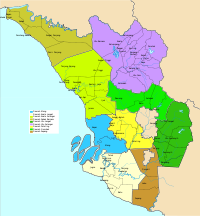Templer Park
Templer Park (Malay: Hutan Lipur Templer) is a forest reserve in Rawang, Gombak District, Selangor, Malaysia. It is 1,214 hectares in size and it was named in honour of Sir Gerald Templer, a British High Commissioner in Malaya. "On 8 September 1954, His Highness the Sultan of Selangor, the late Sultan Hishamuddin Alam Shah declared that Templer’s Park was 'dedicated by Selangor to serve as a refuge and a sanctuary for wildlife and a meeting-place for all who love and respect the beauty of nature'. The following year the government gazetted the area as “a Botanical Garden and Public Park” under the land enactment (Notification 104-1955)".[1]
| Templer Park Hutan Lipur Templer | |
|---|---|

| |
| Type | Forest reserve |
| Location | Rawang, Gombak, Selangor, Malaysia |
| Coordinates | 3.2863296°N 101.6423534°E |
| Area | 1,214 hectares |
| Created | 8 September 1954 |
This forest reserve consists of multi-tiered waterfalls, jungle streams and trails. Several amenities are available in this forest reserve, such as picnic grounds, fishing spots, parking lots, public toilets and stalls.
Wildlife that can be spotted in Templer's Park include the park monkey, the hawk-cuckoo, the crested serpent eagle, the emerald dove, the forest wagtail, malkohas, the barbet, the woodpecker, the flycatcher-shrike, the blue-winged leafbird, the earless agamid, the Malaysian crested lizard, various kinds of toads and snakes and serow (goat-antelopes). Studies by Malaysian Nature Society have confirmed that there is still a population of serow living in the vicinity.[2] The cave, Gua Anak Takun, is home to a rare species of trapdoor spider, Liphistius batuensis.[3]
Templar Park is the type locality where the holotype of the Malaysian spine-jawed snake Xenophidion schaeferi was collected in 1988. To date this is the only known specimen of this rare snake, which belongs in the obscure and primitive snake family Xenophidiidae. The family contains only one other species, X. acanthognathus, also only known from its holotype, which was collected in Sabah, northeast Borneo. These snakes are harmless, nonvenomous, and thought to feed on earthworms or insect larvae.
Threats from Development
The integrity and natural character of Templer's Park is under threat from controversial recent developments which are apparently either a.) adjacent to the park on former parkland which was sold to private interests, or b.) illegally taking place on actual parkland. Developments such as T-Parkland@Templer's Park by the company MCT[4] involved the construction of high-end residences, a 17-story tower block and golf courses. In addition, currently some 50 hectares of ongoing deforestation is taking place for a road and more residences, which will likely impact the quality of the streams in the park due to erosion if this activity continues. Surprisingly, this activity seems to have the consent of the local planning authorities, where the site sign carries the license number 'US HS 3 2012 BALAK'.[5] The authorities appear to be unconcerned about this steady loss of forest to developers and have 'yet to lift a finger' according to a local nature resource.[6]
Accessibility
Templer's Park can be accessed from the Rawang exit of the North–South Expressway. The park can also be reached by taking the No 66 bus from Puduraya in Kuala Lumpur.[7]
Incidents
In 2008, a Danish man went missing for 12 hours in Templer's Park before finding his way out of the jungle. He went missing at an altitude of 500 feet above sea level.[8]
References
- http://www.mns.my/article.php?aid=2037
- http://www.mns.my/article.php?aid=2037
- T.W. Lim and S.S. Yussof (2009). "Conservation status of Batu Caves Trapdoor Spider (Liphistius batuensis Abraham (Araneae, Mesothelae)): A preliminary survey. 61: 121-132". Malayan Nature Journal. 62 (1): 121–132.
- "Archived copy". Archived from the original on 2012-11-18. Retrieved 2012-11-09.CS1 maint: archived copy as title (link)
- http://www.mns.my/article.php?aid=2037
- http://www.naturemalaysia.com/templer-park.htm
- "Templer Park". Virtual Malaysia. Retrieved 2010-08-27.
- "Lelaki Denmark ditemui semula selepas sesat 12 jam di hutan Templer". mStar Online (in Malay). Retrieved 2010-08-27.
